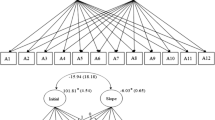Abstract
The present set of studies tested the explanatory and predictive generality of self-efficacy theory across additional treatment modalities and behavioral domains. Microanalysis of changes accompanying symbolic modeling indicates that this mode of treatment enhances coping behavior partly through its effects on perceived efficacy. Cognizing modeled mastery of threats increased phobics' self-percepts of efficacy, which, in turn, predicted their specific performance attainments on tasks of varying threat value. Examination of efficacy probes revealed that making efficacy judgments has no effect on subsequent avoidance behavior or on fear arousal. The close congruence found between changes in self-efficacy and different forms of coping behavior in the treatment of agoraphobia provides some evidence for the generality of efficacy theory across different areas of functioning. Microanalysis of anticipatory and performance fear arousal accompanying varying strengths of self-efficacy also lends support for the social learning conception of fear arousal in terms of perceived coping inefficacy.
Similar content being viewed by others
Reference Notes
Schunk, D. A.Self-efficacy in achievement behavior. Unpublished doctoral dissertation, Stanford University, 1979.
Miller, S. M., & Grant, R. P.Predictability and human stress: Evidence, theory, and conceptual clarification. Unpublished manuscript, University of Pennsylvania, 1979.
References
Averill, J. Personal control over aversive stimuli and its relationship to stress.Psychological Bulletin 1973,80 286–303.
Bandura, A. Social learning perspective on behavior change. In A. Burton (Ed.),What makes behavior change possible? New York: Brunner/Mazel, 1976.
Bandura, A. Self-efficacy: Toward a unifying theory of behavioral change.Psychological Review 1977,84 191–215.
Bandura, A. Reflections on self-efficacy. In S. Rachman (Ed.),Advances in behaviour research and therapy (Vol. 1). Oxford: Pergamon Press, 1978.
Bandura, A. Self-referent thought: The development of self-efficacy. In J. H. Flavell & L. D. Ross (Eds.),Cognition and social development: Frontiers and possible futures. New York: Cambridge Press, 1980, in press.
Bandura, A., & Adams, N. E. Analysis of self-efficacy theory of behavioral change.Cognitive Therapy and Research 1977,1 287–308.
Bandura, A., Adams, N. E., & Byer, J. Cognitive processes mediating behavioral change.Journal of Personality and Social Psychology 1977,35 125–139.
Bandura, A., & Barab, P. G. Processes governing disinhibitory effects through symbolic modeling.Journal of Abnormal Psychology 1973,82 1–9.
Bandura, A., Blanchard, E. B., & Ritter, B. Relative efficacy of desensitization and modeling approaches for inducing behavioral, affective, and attitudinal changes.Journal of Personality and Social Psychology 1969,13 173–199.
Black, A. H. Cardiac conditioning in curarized dogs. The relationship between heart rate and skeletal behaviour. In W. P. Prokasy (Ed.),Classical conditioning: A symposium. New York: Appleton-Century-Crofts, 1965.
Bolles, R. C. The avoidance learning problem. In G. Bower (Ed.),The psychology of learning and motivation (Vol. 6). New York: Academic Press, 1972.
Brown, I., Jr., & Inouye, D. K. Learned helplessness through modeling: The role of perceived similarity in competence.Journal of Personality and Social Psychology 1978,36 900–908.
Dweck, C. S., & Gilliard, D. Expectancy statements as determinants of reactions to failure: Sex differences in persistence and expectancy change.Journal of Personality and Social Psychology 1975,32 1077–1084.
Eysenck, H. J. Expectations as causal elements in behavioral change. In S. Rachman (Ed.),Advances in behaviour research and therapy (Vol. 1). Oxford: Pergamon Press, 1978.
Hardy, A. B.Agoraphobia: Symptoms, causes, treatment. Menlo Park, California: Terrap, 1976.
Herrnstein, R. J. Method and theory in the study of avoidance.Psychological Review 1969,76 49–69.
Kazdin, A. E. Covert modeling and the reduction of avoidance behavior.Journal of Abnormal Psychology 1973,81 87–95.
Kazdin, A. E. Effects of covert modeling and reinforcement on assertive behavior.Journal of Abnormal Psychology 1974,83 240–252. (a)
Kazdin, A. E. Covert modeling, model similarity, and reduction of avoidance behavior.Behavior Therapy 1974,5 325–340. (b)
Kazdin, A. E. Covert modeling, imagery assessment, and assertive behavior.Journal of Consulting and Clinical Psychology 1975,43 716–724.
Kazdin, A. E. Effects of covert modeling, multiple models, and model reinforcement on assertive behavior.Behavior Therapy 1976,7 211–222.
Meichenbaum, D.Cognitive-behavior modification: An integrative approach. New York: Plenum Press, 1977.
Miller, S. M. Controllability and human stress: Method, evidence and theory.Behaviour Research and Therapy 1979,17 287–304.
Rachman, S., & Hodgson, R. Synchrony and desynchrony in fear and avoidance.Behaviour Research and Therapy 1974,12 311–318.
Rescorla, R. A., & Solomon, R. L. Two-process learning theory: Relationships between Pavlovian conditioning and instrumental learning.Psychological Review 1967,74 151–182.
Schwartz, B.Psychology of learning and behavior. New York: Norton, 1978.
Wolpe, J. Self-efficacy theory and psychotherapeutic change: A square peg for a round hole. In S. Rachman (Ed.),Advances in behaviour research and therapy (Vol. 1). Oxford: Pergamon Press, 1978.
Zajonc, R. B., & Brickman, P. Expectancy and feedback as independent factors in task performance.Journal of Personality and Social Psychology 1969,11 148–156.
Author information
Authors and Affiliations
Additional information
This research was supported by Public Health Research Grant M-5162 from the National Institute of Mental Health. The authors are grateful to Seanna Adamson for administering the assessment procedures and to Evelyn Nast for her able assistance with the cognitive modeling treatment. We are deeply indebted to Sue Lampson for her valuable aid with the assessment phase of the agoraphobia study and to the staff of the Terrap treatment center for their generous help with this research.
Rights and permissions
About this article
Cite this article
Bandura, A., Adams, N.E., Hardy, A.B. et al. Tests of the generality of self-efficacy theory. Cogn Ther Res 4, 39–66 (1980). https://doi.org/10.1007/BF01173354
Issue Date:
DOI: https://doi.org/10.1007/BF01173354




